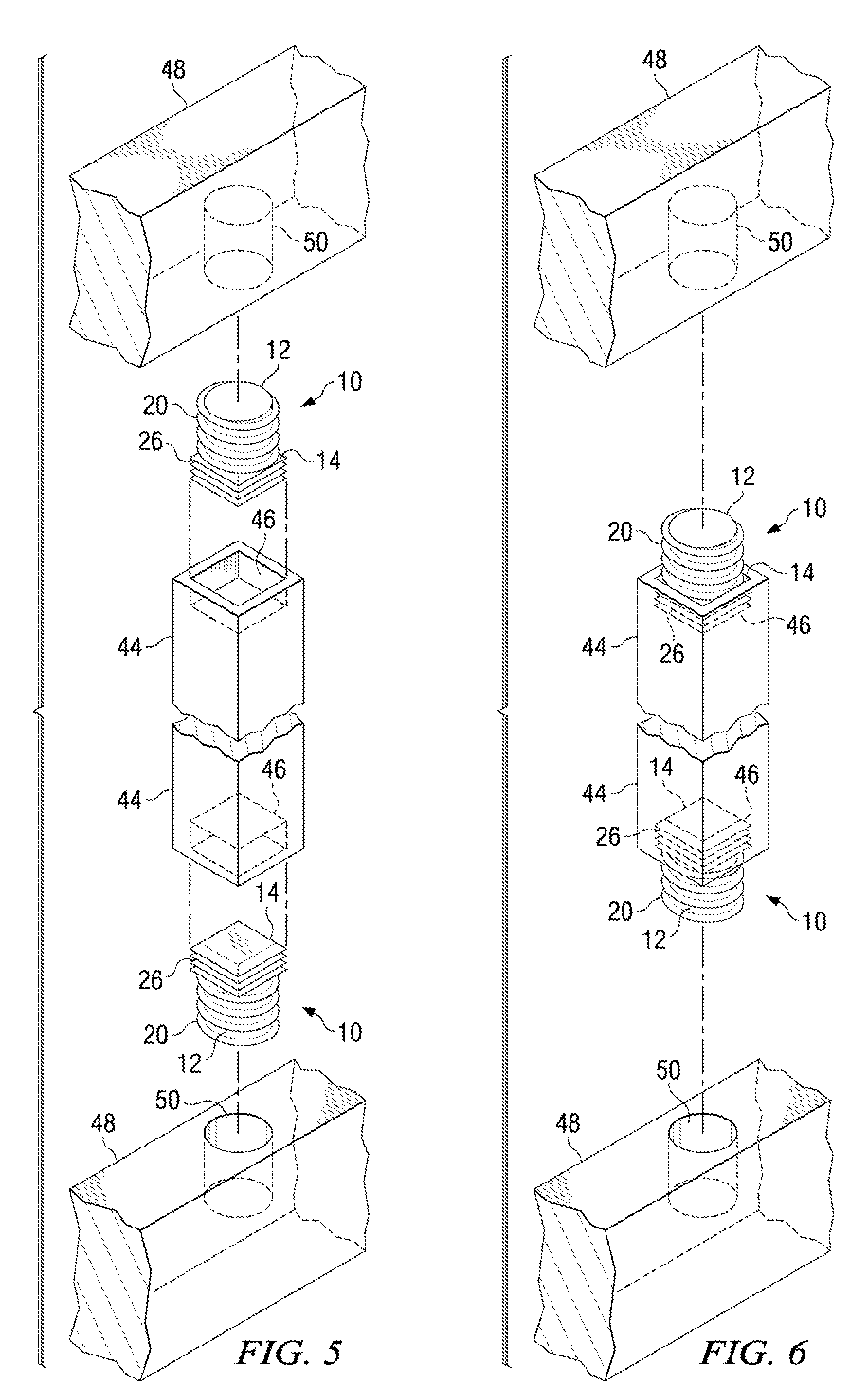Fasteners, railing system and method of assembly
a technology of fasteners and railings, applied in the direction of rod connections, other domestic objects, mechanical devices, etc., can solve the problems of not being suitable for the purposes of an aspect of invention, not having a satisfactory appearance, and inadequate means of affixing pickets to the railings of the fence, etc., to achieve the effect of reducing labor intensity, reducing labor intensity and reducing labor intensity
- Summary
- Abstract
- Description
- Claims
- Application Information
AI Technical Summary
Benefits of technology
Problems solved by technology
Method used
Image
Examples
first embodiment
[0034]Referring now to the drawings and, in particular, to FIG. 1 through FIG. 3 wherein there are illustrated a fastener 10 for assembling a picket fence. The fastener 10 is a one-piece, unitary device that is comprised of a cylindrical member 12 and a rectangular member 14. The cylindrical member 12 consists of a first end 16 that is connected to the rectangular member 14 and an opposed second end 18. Screw threads 20 surround the cylindrical member 12. Desirably, fasteners 10 are fabricated of two types: fasteners 10 having screw threads 20 which fasten in a clockwise direction, and fasteners 10 having screw threads 20 which fasten in a counterclockwise direction. The rectangular member is comprised of a first end 22 that is connected to the cylindrical member 12 and a second opposed end 24. A series of parallel ridges 26 is located on the four sidewalls of the rectangular member 14. The rectangular member 14 is desirably sized to fit an opening of a readily available picket 44 (...
second embodiment
[0035]Referring to FIG. 4, therein illustrated is the fastener 28. The fastener 28 is comprised of a cylindrical member 30 and a rectangular member 32, said cylindrical member 30 consisting of a first end 34 connected to the rectangular member 32 and a second opposed end 36. The rectangular member 32 is comprised of a first end 38 that is connected to the cylindrical member 30 and a second opposed end 40. Parallel ridges 42 are located on the four sidewalls of the rectangular member 32.
[0036]The fasteners 10, 28 are comprised of material that is lightweight and durable. Exemplary materials include plastics, nylon, polyvinyl chloride, and other deformable materials including but not limited to synthetic rubber and polyurethane and nondeformable materials such as metals including, but not limited to aluminum, zinc, galvanized steel, carbon steel and stainless steel.
[0037]As displayed in FIG. 5 a picket fence is being assembled with an elongate, rectangular picket 44 having rectangular...
third embodiment
[0040]a fastener 52 is illustrated in FIG. 9 as having a conical member 54 with surrounding screw threads, said conical member 54 tapering from a narrower end to a wider end with said wider end connected to a rectangular member 56. The fastener 52 is aligned between an end of a picket 44 with cooperating bore 46 and a communicating side of a fence rail 58. Two types of fasteners 52 are desirably provided, a first in which the conical member 54 has clockwise-fastening threads, and a second in which the conical member 54 has counterclockwise-fastening threads.
[0041]The picket 44 is attached to upper and lower rails 58 by first inserting the rectangular member 56 of the fastener 52 into the bore 46 at opposed ends of the picket 44 so that the rectangular member 56 frictionally engages the surrounding sidewalls of the bore 46 and anchors the fastener 52 to the picket 44. The picket 44 with the fastener 52 disposed therein is placed adjacent to the rails 58 in perpendicular relation and ...
PUM
 Login to View More
Login to View More Abstract
Description
Claims
Application Information
 Login to View More
Login to View More - R&D
- Intellectual Property
- Life Sciences
- Materials
- Tech Scout
- Unparalleled Data Quality
- Higher Quality Content
- 60% Fewer Hallucinations
Browse by: Latest US Patents, China's latest patents, Technical Efficacy Thesaurus, Application Domain, Technology Topic, Popular Technical Reports.
© 2025 PatSnap. All rights reserved.Legal|Privacy policy|Modern Slavery Act Transparency Statement|Sitemap|About US| Contact US: help@patsnap.com



